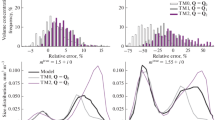This study discusses the topical problem of expanding the application scope of elastic scattering lidars for determining the microstructure of the atmospheric surface layer containing polydisperse and nonspherical particles of various natures. We propose to interpret the atmospheric layer microstructure as an equivalent scattering medium that consists of monodisperse particles. A comparative analysis of two methods of determining particle concentrations in the scattering surface layer of the atmosphere from lidar backscattering signals with simultaneous registration of the angular characteristics of the scattering halo of the sensing beam and from the results of contact measurements using a nephelometer was performed. As part of the equivalent medium model, the microphysical interpretation of the backscattering and extinction coefficients measured by the lidar is considered. Methods of determining the concentration of equivalent particles of the model scattering medium by measuring the scattering signals of individual particles in the forward and backward directions using a nephelometer are compared. The concentration of equivalent particles is determined from the results of relative measurements of the signals generated by scattering of light radiation by individual particles, and it is observed to be proportional to the ratio of the square of the nonnormalized, first-order moment to the nonnormalized, second-order moment. Noteworthily, the nonnormalized moments determined from backscattering depend on particle albedo, whereas those determined from forward scattering are practically independent of particle albedo. Furthermore, simultaneous measurements of signals generated by forward and backward scattering of radiation by individual particles enable to determine the relationship between the backscattering and extinction coefficients necessary for solving the lidar equation, and then to use the backscattering coefficient to determine the concentrations of equivalent particles. The results of the analysis enable to uniquely compare the concentration of equivalent particles with the measured backscattering signal. The results obtained can be applied in development of remote methods of monitoring aerosol pollution of the surface layer of the atmosphere.
Similar content being viewed by others
References
P. Kulkarni, P. A. Baron, and K. Willeke, Aerosol Measurement: Principles, Techniques, and Applications, 3rd ed., Wiley Inc., New York (2011), https://doi.org/10.1002/9781118001684.
R. M. Measures, Laser Remote Sensing: Fundamentals and Applications, Wiley, New York (1983).
G. P. Arumov and A. V. Bukharin, Selection of Optimal Paths for Remote Measurements of the Microstructure of a Scattering Object, Izmer. Tekh., No. 10, 31–36 (2022), https://doi.org/10.32446/0368-1025it.2022-10-31-36.
I. Veselovskii, A. Kolgotin, V. Griaznov, D. Muller, U. Wandinger, and D. N. Whiteman, Appl. Opt., 41, No. 18, 3685–3699 (2002), https://doi.org/https://doi.org/10.1364/AO.41.003685.
M. I. Mishchenko, J Quant. Spectrosc. Radiat. Transf., 110, No. 11, 808–832 (2009), https://doi.org/https://doi.org/10.1016/jjqsrt.2008.12.005.
G. P. Arumov, A. V. Bukharin, Use of Special Screens Simulating Radiation Scattered in a Medium to Measure the Equivalent Cross Section of Particles, Sovr. Problemy Distants. Zondir. Zemli Kosmosa, 18, No. 3, 298–306 (2021), https://doi.org/10.21046/2070-7401-2021-18-3-298-306.
G. P. Arumov, A. V. Bukharin, and V. S. Makarov, Three-Dimensional Reflecting Objects in the Problem of Modeling a Lidar Signal from a Scattering Layer, Sovr. Problemy Distants. Zondir. Zemli Kosmosa, 19, No. 4, 328–334 (2022), https://doi.org/10.21046/2070-7401-2022-19-4-328-334.
C. F. Bohren and D. R. Huff man, Absorption and Scattering of Light by Small Particles, Wiley, New York (1983).
V. V. Veretennikov, V. S. Kozlov, I. E. Naats, and V. Ya. Fadeev, Opt. Lett., 4, No. 12, 411–413 (1979), https://doi.org/https://doi.org/10.1364/OL4.000411.
K. Y. Glenn, Appl. Opt., 39, No. 30, 5446–5455 (2000), https://doi.org/https://doi.org/10.1364/AO.39.005488.
Author information
Authors and Affiliations
Corresponding author
Additional information
Translated from Izmeritel'naya Tekhnika, No. 4, pp. 38–43, April, 2023. https://doi.org/10.32446/0368-1025it.2023-4-38-43
Rights and permissions
Springer Nature or its licensor (e.g. a society or other partner) holds exclusive rights to this article under a publishing agreement with the author(s) or other rightsholder(s); author self-archiving of the accepted manuscript version of this article is solely governed by the terms of such publishing agreement and applicable law.
About this article
Cite this article
Arumov, G.P., Bukharin, A.V. Comparison of Methods of Determining Particle Concentrations in a Model Scattering Layer for an Elastic Scattering Lidar. Meas Tech 66, 252–258 (2023). https://doi.org/10.1007/s11018-023-02218-5
Received:
Accepted:
Published:
Issue Date:
DOI: https://doi.org/10.1007/s11018-023-02218-5




